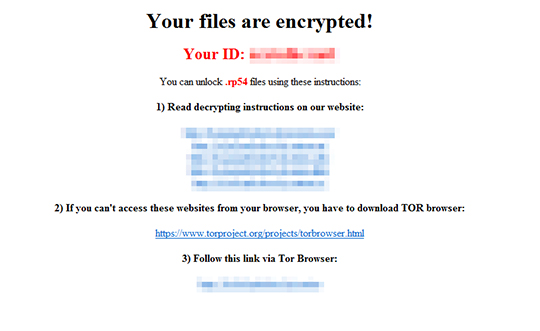RANSOM_PRINCESSLOCKER.A
Win32/Filecoder.AlmaLocker.B (ESET-NOD32)
Windows


Threat Type: Trojan
Destructiveness: No
Encrypted: No
In the wild: Yes
OVERVIEW
Dropped by other malware, Downloaded from the Internet
This Trojan arrives on a system as a file dropped by other malware or as a file downloaded unknowingly by users when visiting malicious sites.
It connects to certain websites to send and receive information.
TECHNICAL DETAILS
403,968 bytes
EXE
No
10 Oct 2016
Connects to URLs/IPs, Displays graphics/image, Encrypts files
Arrival Details
This Trojan arrives on a system as a file dropped by other malware or as a file downloaded unknowingly by users when visiting malicious sites.
Installation
This Trojan drops the following file(s)/component(s):
- {Path of encrypted file}\!_HOW_TO_RESTORE_{random character}.txt
- {Path of encrypted file}\!_HOW_TO_RESTORE_{random character}.htm
- {Path of encrypted file}\!_HOW_TO_RESTORE_{random character}.url
It adds the following mutexes to ensure that only one of its copies runs at any one time:
- ApiResolver
Other Details
This Trojan connects to the following URL(s) to get the affected system's IP address:
- http://myexternalip.com/raw
It connects to the following website to send and receive information:
- http://{BLOCKED}f6fqi63p6m.{BLOCKED}n.link/n.php
It encrypts files with the following extensions:
- .1cd
- .3ds
- .3gp
- .accdb
- .ai
- .ape
- .asp
- .aspx
- .bc6
- .bc7
- .bmp
- .cdr
- .cer
- .cfg
- .cfgx
- .cpp
- .cr2
- .crt
- .crw
- .csr
- .csv
- .dbf
- .dbx
- .dcr
- .dfx
- .dib
- .djvu
- .doc
- .docm
- .docx
- .dwg
- .dwt
- .dxf
- .dxg
- .eps
- .htm
- .html
- .ibank
- .indd
- .jfif
- .jpe
- .jpeg
- .jpg
- .kdc
- .kwm
- .max
- .md
- .mdb
- .mdf
- .odb
- .odc
- .odm
- .odp
- .ods
- .odt
- .orf
- .p12
- .p7b
- .p7c
- .pef
- .pem
- .pfx
- .php
- .pl
- .png
- .pps
- .ppt
- .pptm
- .pptx
- .psd
- .pst
- .pub
- .pwm
- .py
- .qbb
- .qbw
- .raw
- .rtf
- .sln
- .sql
- .sqlite
- .svg
- .tif
- .tiff
- .txt
- .vcf
- .wallet
- .wpd
- .xls
- .xlsm
- .xlsx
- .xml
It renames encrypted files using the following names:
- {orginal filename and extension}.{random character}
It does the following:
- It skips to encrypt the following paths:
- \$recycle.bin\
- \system volume information\
- \program files\
- \programdata\
- \program files (x86)\
- \windows\
- \internet explorer\
- \microsoft\
- \mozilla\
- \chrome\
- \appdata\
- \local settings\
- \recycler\
- \msocache\
- It displays the following ransom note:

SOLUTION
9.800
12.828.06
10 Oct 2016
12.829.00
11 Oct 2016
Step 1
Before doing any scans, Windows XP, Windows Vista, and Windows 7 users must disable System Restore to allow full scanning of their computers.
Step 2
Note that not all files, folders, and registry keys and entries are installed on your computer during this malware's/spyware's/grayware's execution. This may be due to incomplete installation or other operating system conditions. If you do not find the same files/folders/registry information, please proceed to the next step.
Step 3
Search and delete these files
- {Path of encrypted file}\!_HOW_TO_RESTORE_{random character}.txt
- {Path of encrypted file}\!_HOW_TO_RESTORE_{random character}.htm
- {Path of encrypted file}\!_HOW_TO_RESTORE_{random character}.url
Step 4
Scan your computer with your Trend Micro product to delete files detected as RANSOM_PRINCESSLOCKER.A. If the detected files have already been cleaned, deleted, or quarantined by your Trend Micro product, no further step is required. You may opt to simply delete the quarantined files. Please check this Knowledge Base page for more information.
Step 5
Restore encrypted files from backup.
Did this description help? Tell us how we did.

